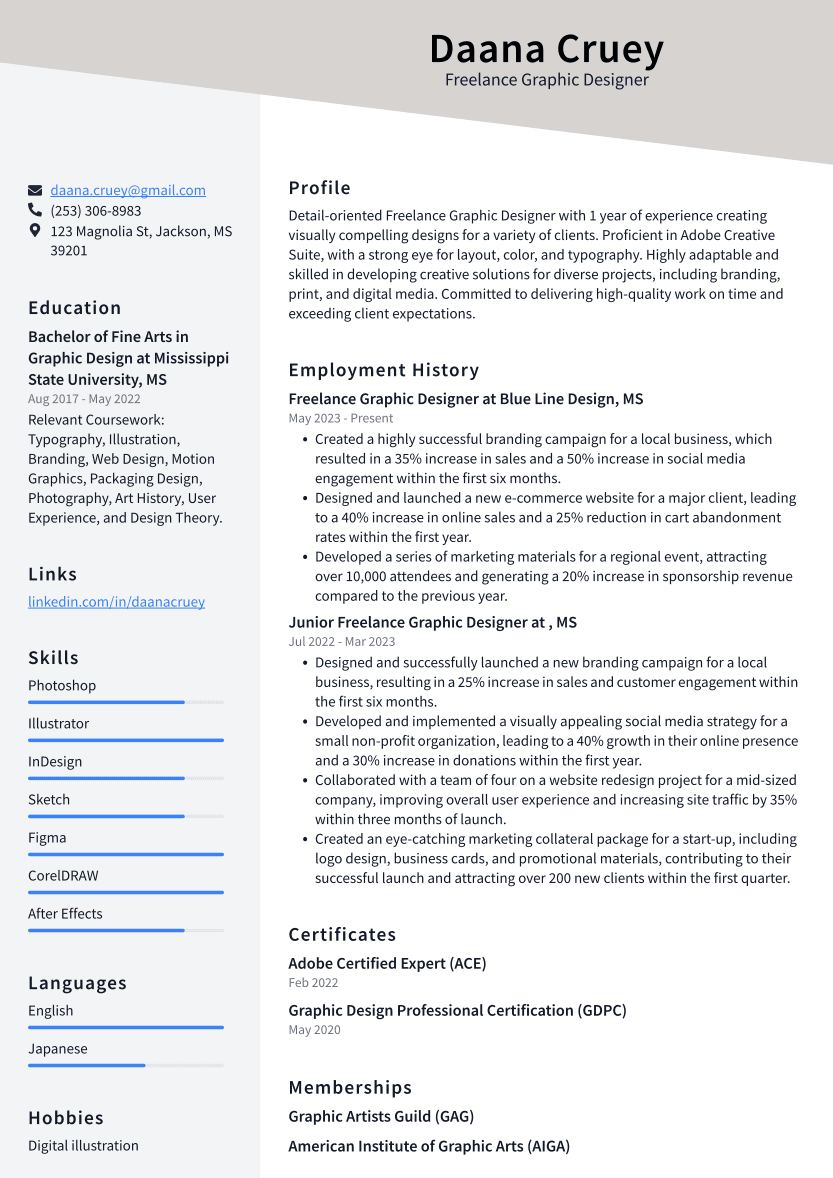Freelance Graphic Designer Resume Examples
Writing a great freelance graphic designer resume is important because it is one of the first things a potential employer will see when they are considering you for a position. It is your opportunity to make a good first impression and sell yourself as the best candidate for the job.
Create your resume
Select from 7 professional resume templates
If you're looking for inspiration when it comes to drafting your own freelance graphic designer resume, look no further than the samples below. These resumes will help you highlight your experience and qualifications in the most effective way possible, giving you the best chance of landing the freelance graphic designer job you're after.
Essential Components of a Freelance Graphic Designer's Resume
For freelance graphic designers, crafting a compelling resume is crucial to attract potential clients and showcase their design prowess. An effective resume not only highlights your design skills but also demonstrates your technical abilities and experience in the field. Let's delve into the key sections of a resume, their significance, and how to optimize them to create an impactful freelance graphic designer resume.
1. Contact Information
Begin your resume with clear contact information to ensure clients can easily reach you.

Include the following:
- Full Name: Prominently display your name at the top of your resume.
- Phone Number: Provide a reliable contact number.
- Email Address: Use a professional email address for correspondence.
- Location: Mention your city and country for time zone reference.
- Professional Website or Portfolio Link: An online portfolio is essential for showcasing your work.
- LinkedIn Profile: Include your LinkedIn profile for additional professional details.
- Video Call IDs: Offer your Skype ID or other video conferencing IDs for virtual meetings.
Avoid sharing personal details not relevant to your professional capabilities.
Clear contact information establishes your professionalism and accessibility as a freelance graphic designer.
2. Professional Summary or Objective
The professional summary or objective serves as your introduction, highlighting your key skills, experiences, and achievements relevant to the role you're targeting.
Customize this section to reflect your unique value proposition as a freelance graphic designer, succinctly stating your expertise in areas such as logo design, branding, or digital illustration.
A compelling summary or objective should touch on:
- Years of experience in the industry
- Notable clients or projects
- Proficiency in design software like Adobe Creative Suite
- Soft skills like creativity and communication
Keep it concise to entice the reader to learn more about you.
Related: Top Freelance Graphic Designer Resume Objective Examples
3. Skills and Competencies
This section showcases your technical and creative skills, aligning with the requirements of the job posting.
- Technical Skills: Detail your proficiency with design software and tools.
- Creativity: Highlight your ability to generate innovative concepts.
- Typography: Emphasize your knowledge of typography in various design contexts.
- Color Theory: Demonstrate your understanding of color and its impact on design.
- Communication Skills: Mention your ability to effectively communicate with clients.
- Time Management: Showcase your capability to handle multiple projects efficiently.
- Problem-Solving Skills: Describe your approach to overcoming design challenges.
- Business Acumen: Include knowledge of marketing strategies and business operations.
Illustrate how you've successfully applied these skills in previous roles or projects.
Related: Freelance Graphic Designer Skills: Definition and Examples
4. Work Experience/Portfolio
Your experience and portfolio are the heart of your resume, demonstrating your career trajectory and skill application.
- Comprehensive Work History: List relevant positions in reverse chronological order, including job titles, companies, dates, and locations.
- Portfolio: Provide links to an online portfolio that showcases your best work, tailored to the job you're applying for.
- Project Summaries: Offer concise descriptions of key projects, your role, tools used, and any measurable outcomes.
- Client Testimonials: Include positive feedback from clients to validate your expertise.
- Diverse Design Work: Display a range of design work to show versatility.
This section should narrate your professional journey as a graphic designer and the unique skills you bring to the table.
5. Education and Certifications
Highlight your formal education and any certifications that enhance your qualifications as a graphic designer.
- Education: List your educational background, emphasizing degrees and relevant coursework in graphic design or related fields.
- Certifications: Include certifications from recognized institutions that attest to your specialized skills.
- Additional Training: Mention any workshops or seminars that contribute to your continuous professional development.
- Skills Acquired: Note the key skills gained from each educational or training experience.
Present this information in reverse chronological order, showcasing how your education supports your freelance graphic design work.
Related: Freelance Graphic Designer Certifications
6. Awards and Achievements
This section highlights awards and recognitions that attest to your skill and dedication to graphic design.
- Include awards from design competitions or industry organizations.
- Detail successful projects that had a significant impact on clients.
- List milestones such as managing large-scale projects or working with notable clients.
Organize your achievements in reverse chronological order and provide context for each accolade.
Featuring awards and achievements enhances your credibility and showcases your commitment to excellence in the field.
7. References
References can bolster your resume by affirming your skills and experience.
Choose references who can vouch for your graphic design expertise and professionalism, such as past clients or colleagues.
It's common for freelancers to indicate "References available upon request" to tailor references for each job application.
While references are valuable, remember that your portfolio is the most critical element in demonstrating your abilities as a graphic designer.
By focusing on these key elements and presenting them effectively, you can create a resume that captures the attention of potential clients and showcases your talents as a freelance graphic designer.